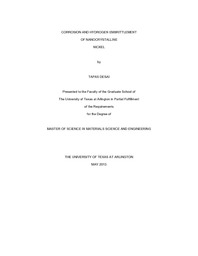
ATTENTION: The works hosted here are being migrated to a new repository that will consolidate resources, improve discoverability, and better show UTA's research impact on the global community. We will update authors as the migration progresses. Please see MavMatrix for more information.
Show simple item record
| dc.contributor.author | Desai, Tapas | en_US |
| dc.date.accessioned | 2013-07-22T20:13:20Z | |
| dc.date.available | 2013-07-22T20:13:20Z | |
| dc.date.issued | 2013-07-22 | |
| dc.date.submitted | January 2013 | en_US |
| dc.identifier.other | DISS-12261 | en_US |
| dc.identifier.uri | http://hdl.handle.net/10106/11796 | |
| dc.description.abstract | Nanocrystalline (nc) materials have attracted the interest of the scientific community because of their unique physical and mechanical properties. However, limited research has been performed to analyze their electrochemical behavior. The majority of research in the field of electrochemical and corrosion behavior exists for electrodeposited nanocrystalline metals.This research studies the behavior of sputter-deposited nc Nickel films in corrosive and hydrogen environment by potentiodynamic polarization and microindentation. The surface morphology and composition of the samples was examined by Scanning Electron Microscopy and Energy Dispersive X-Ray spectroscopy. Bulk Ni samples exhibit mild passivation in 3.5 % NaCl solution. The surface reveals a fine distribution of small pits and numerous large pits. However, nc Ni films show a higher corrosion potential, but lower corrosion rate. This can be attributed to the rapid formation of a passive film to resist the corrosion, and better purity of sputtered films. A very uniform and periodic corrosion pattern is observed on the surface, without any pitting. In 0.1 N H2SO4 solution, active dissolution of Ni was observed in both bulk and nanocrystalline samples. This is due to the absence of passivation for Ni in this environment. Nc Ni shows a higher corrosion rate and higher anodic corrosion potential. This behavior is attributed to a higher density of grain boundaries that act as a catalyst to the hydrogen reduction reaction and increase the corrosion rate.Effect of electrochemically charged hydrogen was observed for bulk and nanocrystalline Nickel. Bulk Ni displayed a slight increase in hardness and signs of hydrogen induced plastic deformation. On the other hand, the nanocrystalline Ni shows brittle failure by buckling and spalling. This is attributed to its limited ductility and the high density that act as preferred sites for hydrogen adsorption and subsequently enhance hydrogen diffusion, leading to embrittlement. | en_US |
| dc.description.sponsorship | Meletis, Efstathios | en_US |
| dc.language.iso | en | en_US |
| dc.publisher | Materials Science & Engineering | en_US |
| dc.title | Corrosion And Hydrogen Embrittlement Of Nanocrystalline Nickel | en_US |
| dc.type | M.S. | en_US |
| dc.contributor.committeeChair | Meletis, Efstathios | en_US |
| dc.degree.department | Materials Science & Engineering | en_US |
| dc.degree.discipline | Materials Science & Engineering | en_US |
| dc.degree.grantor | University of Texas at Arlington | en_US |
| dc.degree.level | masters | en_US |
| dc.degree.name | M.S. | en_US |
Files in this item
- Name:
- Desai_uta_2502M_12261.pdf
- Size:
- 9.537Mb
- Format:
- PDF
This item appears in the following Collection(s)
Show simple item record


